Following in the Footsteps of Japan’s First Samurai
2024/02/13
The samurai warrior is a well known cultural icon of Japan, introduced to the world through countless depictions in just about every media format one can possibly imagine. Common things associated with samurai may include mastery of the use of the katana, a strong sense of duty rooted in concepts of Bushido, and giant impractical decorative helmets. One thing that probably does not come to mind as often is an association with Nara Prefecture, which to be fair, is probably more accurate than not; the rise of the samurai class wiped out the Nara-based idea of an an imperial court controlling Japan — besides a brief blip in the 14th century — for almost 700 years. That being said, Nara has seen its share of samurai activity, with the southern mountainous region of Yoshino having a surprising amount historical conflict and visits from famous warriors, one of whom is this focus of this blog: Minamoto no Yoshitsune, the tragic champion of Japan’s first official shogunate.
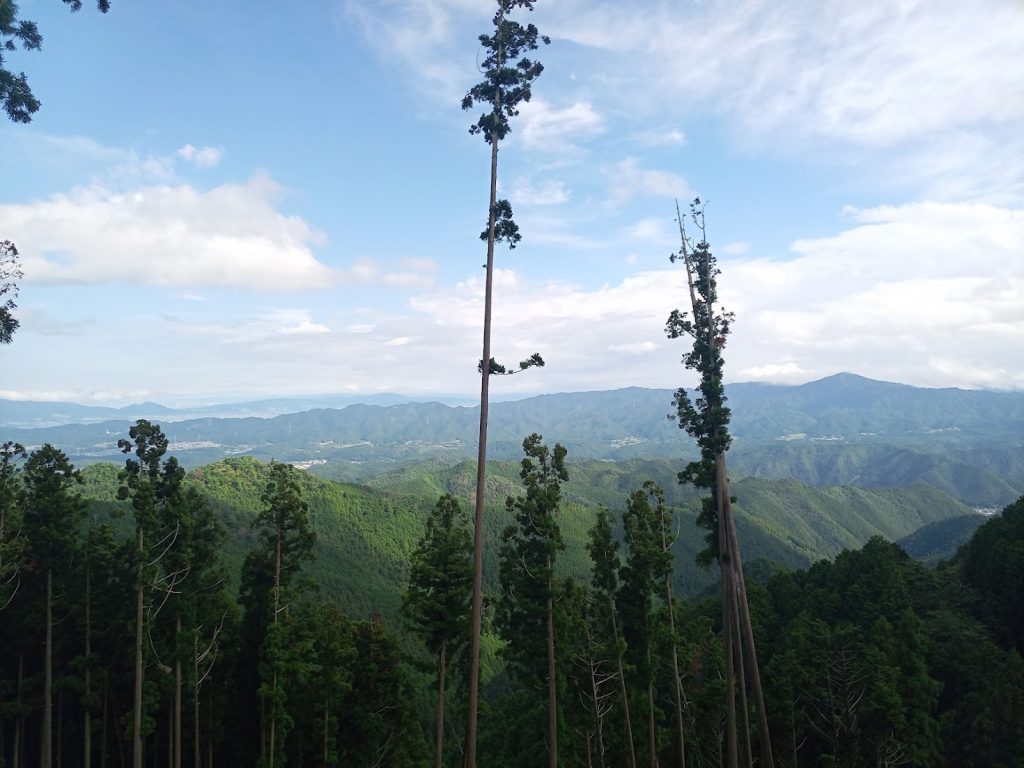
Looking north from the historically influential Yoshino region of Nara Prefecture.
First a bit of background: prior to being a country controlled by the warrior class, Japan had largely been ruled by an imperial court, with an emperor usually mostly controlling things directly from up front or through others from a less prominent position (e.g. cloistered emperors) for roughly 700-800 years, until the end of the 12th century. The eventual change from imperial court control to a shogunate occurred for a number of reasons, but a major theme was the long process in which the imperial court’s direct military power became outclassed by that of regional warrior clans who were less beholden to (and may have benefited less from) the court’s influence. The Imperial Court relied more and more on these clans to uphold its rule, fight its battles, put down rebellions, etc., giving rise to the bitter regional rivalries, leading to the Genpei War (1180-1185 CE), which saw the Minamoto Clan and Taira Clan clash for who would control the country.
The Taira had previously defeated the Minamoto when Minamoto no Yoshitomo (the Minamoto clan leader at the time), rebelled against the Imperial Court in anger over his belief that he had not been properly rewarded for having put down a previous rebellion on behalf of that very same court. Indebted to the powerful Taira for defending them, the Court fell under the clan’s monopolistic control, which stoked the ire of other regional warrior clans, including the still-powerful Minamoto. Armies were formed and the Minamoto once again rose up under Yoshinotomo’s sons, Yoritomo and Yoshitsune, successfully defeating the Taira clan-controlled court and establishing the first shogunate in Japan, a form of government in which a military leader (the “shogun”) was the de facto head of state in Japan.
Minamoto no Yoshitsune’s legendary role as a brilliant military leader and fearless warrior in the Benkei War helped established the early blueprint, so to speak, for the ideal image of what a member of Japan’s newly emerging warrior class was supposed to be. He was said to have lead from the front, charging into battle among his troops on behalf of his clan, and actually winning against the odds. He also was said to have inspired fierce loyalty amongst his companions through his own personal martial prowess; despite reportedly being a man of slim and short build, he bested the giant warrior monk Benkei in a famous midnight duel on the Gojo bridge in Kyoto, recruiting him as a retainer thereafter.
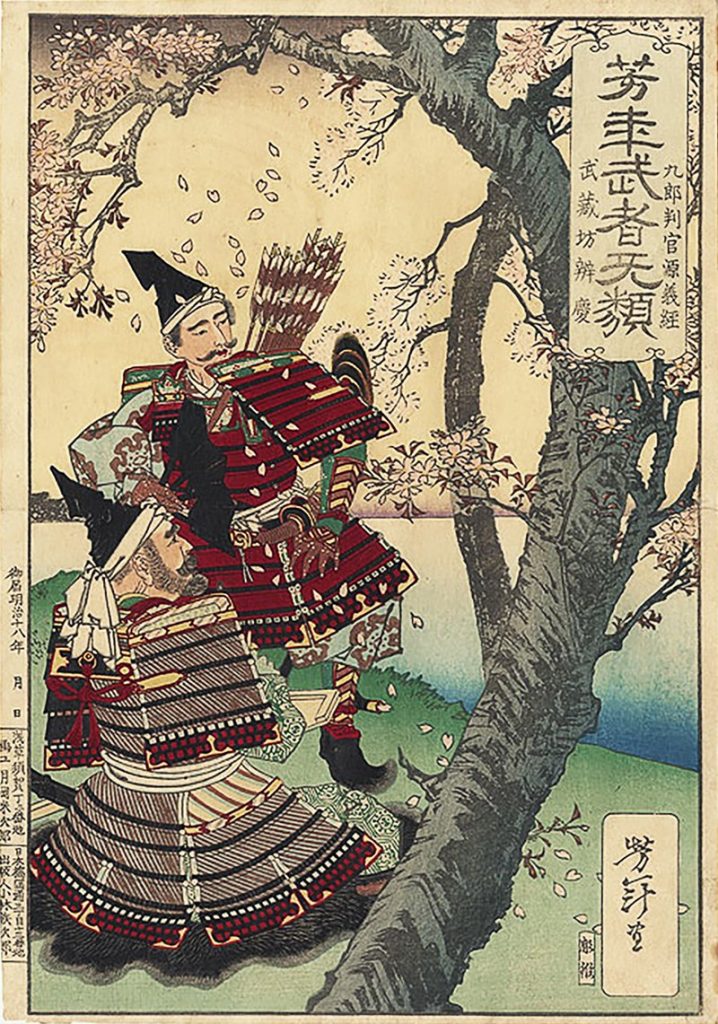
Yoshitoshi Musha Burui No. 15 by Tsukioka Yoshitoshi, 1885. This woodblock print depicts the warrior Minamoto no Yoshitsune (top) with his loyal retainer Benkei (bottom) looking battle-ready while they admire the cherry blossoms — a sensibility that came to be associated with the emerging samurai / warrior class.
However, Yoshitsune and his brother Yoritomo did not see eye-to-eye in the end; it is said the Yoshitsune may not have been aware of his brother’s ultimate ambitions to create a military ruled-government, and thus accepted a position under the service of the Imperial Court, creating bad blood in their relationship. Eventually, Yoshitsune’s opposition to Yoritomo’s vision was discovered and he was forced to flee from Kyoto, with Yoritomo’s men in close pursuit. The flight of Yoshitsune and his band of loyal retainers (including his consort, Lady Shizuka) eventually brought them through Nara Prefecture and the Omine Mountains, where Yoshitsune hoped to lose his pursuers in the rugged landscape with assistance of the local yamabushi monks similar to Benkei himself.
The story of Yoshitsune would end tragically as he was ultimately betrayed and surrounded at a castle in Fukushima Prefecture, where he is said to have committed ritual suicide. Despite this, his position as an important figurehead of the samurai ideal was cemented in history, along with his trusted retainer Benkei who died defending Yoshitsune alone on a bridge against an army of attackers; he reportedly fought so fiercely that he refused to fall down in death, dying from arrow fire while somehow remaining in defiantly in the standing position, buying his master more time. Yoshitsune’s story doesn’t end there however, as there are some other legends that say that he managed to escape — one particularly wild one supposes that he took a boat to mainland of Asia and became Genghis Khan!
Regardless of his fate, during his time in Yoshino, Yoshitsune (and his group of follower) left their mark on both the physical environment and the culture of the area. Let’s take a look at some of the noteworthy places associated with him that you can visit.
The Yoshimizu Shrine
This scenic shrine in Yoshino was previously a temple prior to the Meiji period and used as a home for high ranking priests of the larger Kinpusen-ji Temple district. It is said that Yoshitsune, Lady Shizuka, and Benkei all stayed here together for some time. The shrine claims that they have artifacts left over from Yoshitsune’s group in its on-grounds museum, and a rock which Benkei pushed a metal nail into using his bear hands to demonstrate his power.
—
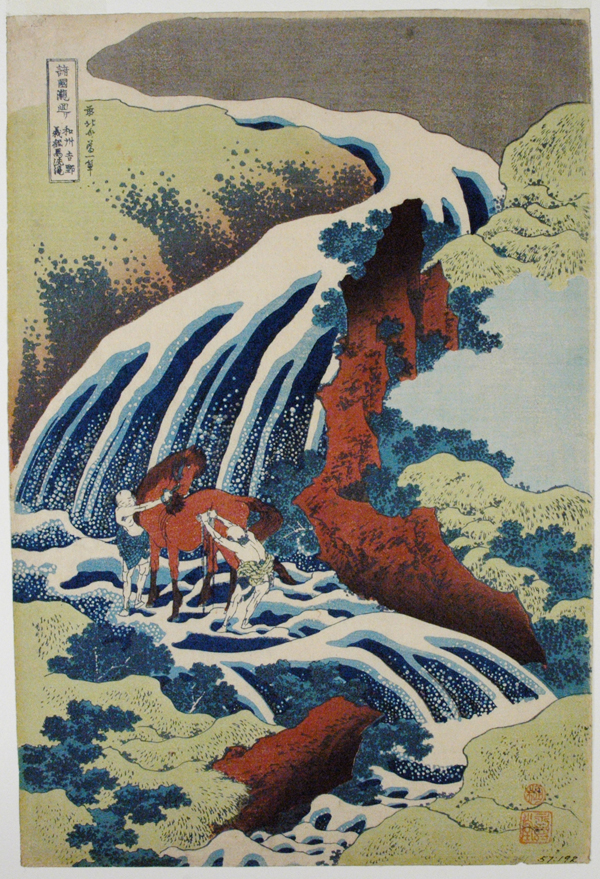
Hokusai’s painting depicting Yoshitsune and Benkei washing a horse in Yoshino, 1832. Source
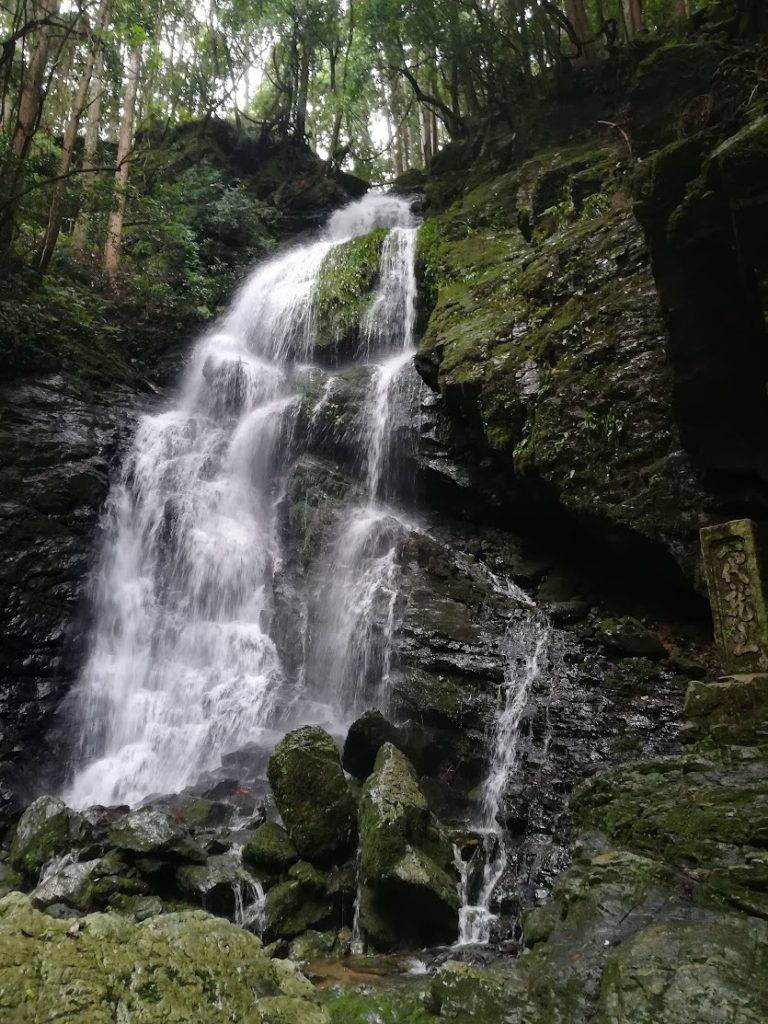
The actual Takataki Waterfall in Yoshino.
Takataki Waterfall
Literally meaning “high waterfall,” this 15 meter high natural sightseeing spot makes up part of the Man’yo-no-michi hiking path between the Miyataki riverside and the Yoshinoyama temple district above. There is poetry written about this area and its clear waters in Japan’s oldest collection of poetry, the Man’yoshu (759 CE). It is said that Yoshitsune and Benkei stopped here together to wash their horses under the waterfall, inspiring the famous Hokusai Ukiyo-e painting posted above. Getting to Takataki Waterfall is a little bit of a hike from Yoshinyama, but well worth the journey for those who want to take-in the beautiful natural scenery
—
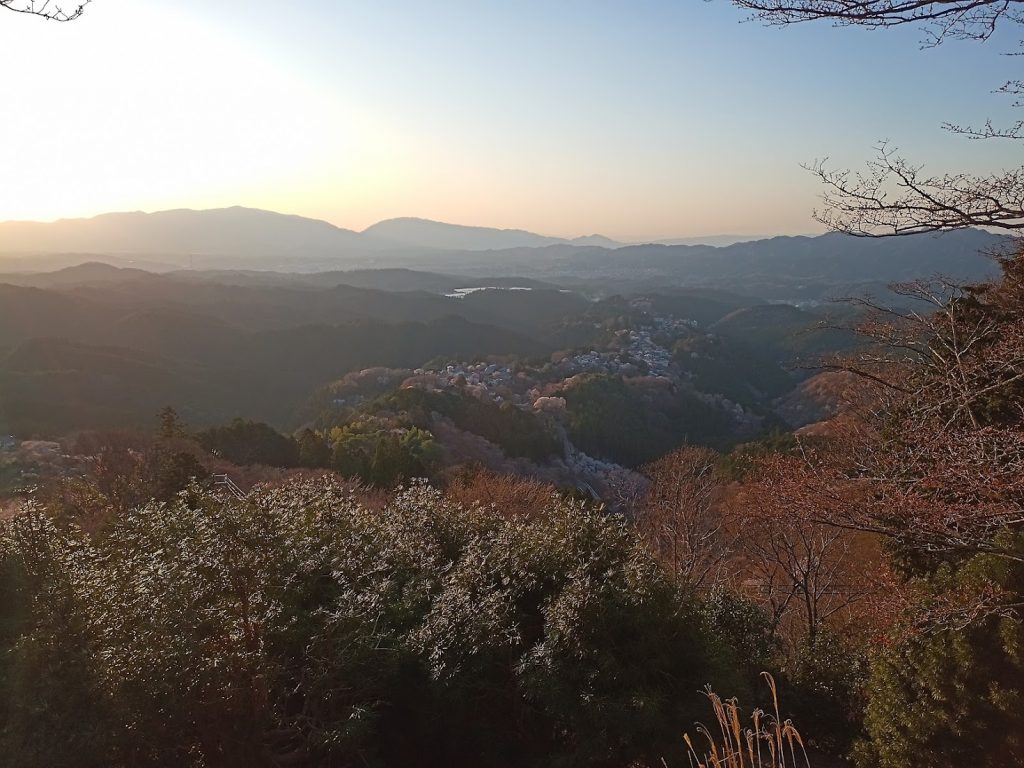
Hanayagura Viewpoint. The Kongo Mountain Range, which lies on the border between Osaka and Nara, can be seen in the distance.
Hanayagura Viewpoint
The most famous viewpoint location in Yoshinoyama for cherry blossoms, this location has a commanding view over the ridgeline temple district of Yoshinoyama. An oddly flat area of an otherwise extremely steep section of mountain, a temple once stood here as well, of which only the bell still remains. It is also the location of a skirmish that once occurred between a defender of Yoshitsune and a local warrior priest in pursuit of him – it’s name roughly translates as “arrow storehouse,” in reference to the story of how Yoshitsune’s defender shot arrows from this position down at the attacker, giving Yoshitsune time to escape. Just below Hanayagura is a grave for the literal head of the attacking warrior monk who was said to have been decapitated by an arrow in his assault on the position.
Though now a must-see point and popular photo spot / rest location (equipped with a vending machine, no less), Hanayagura’s origins tell of us of a time when this land was a temple fortress with warrior priests ready to fight at a moments notice.
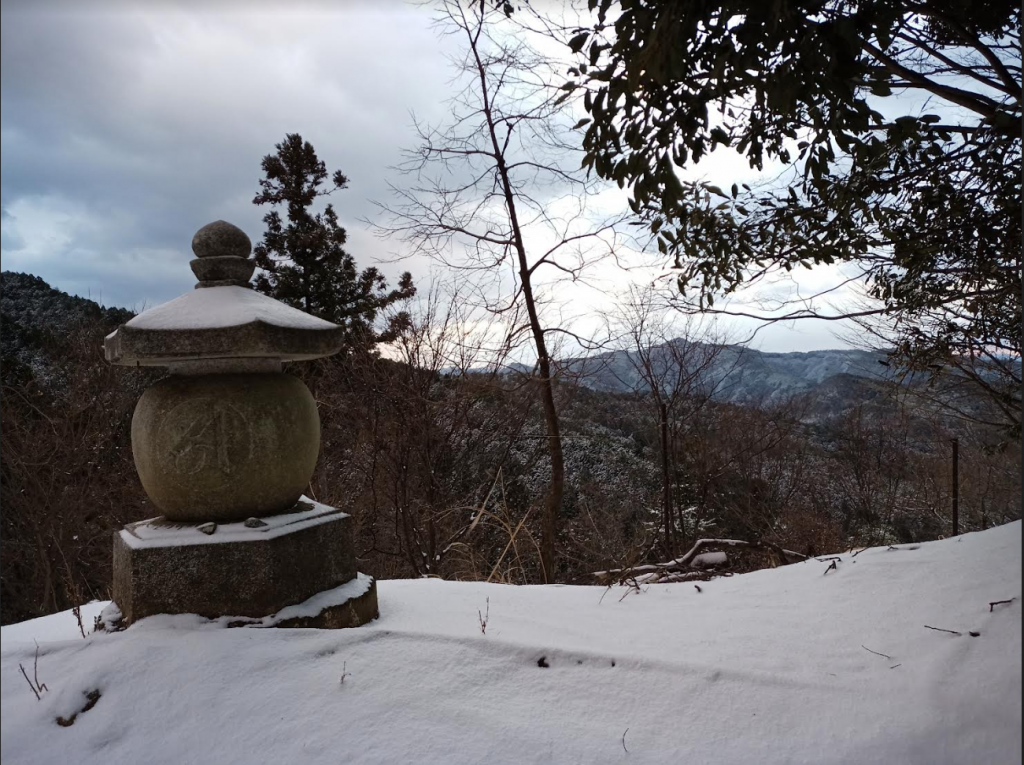
Burial marker for the head of the the warrior priest Yokogawa, who was killed below Hanayagura during his pursuit of Yoshitsune.
—
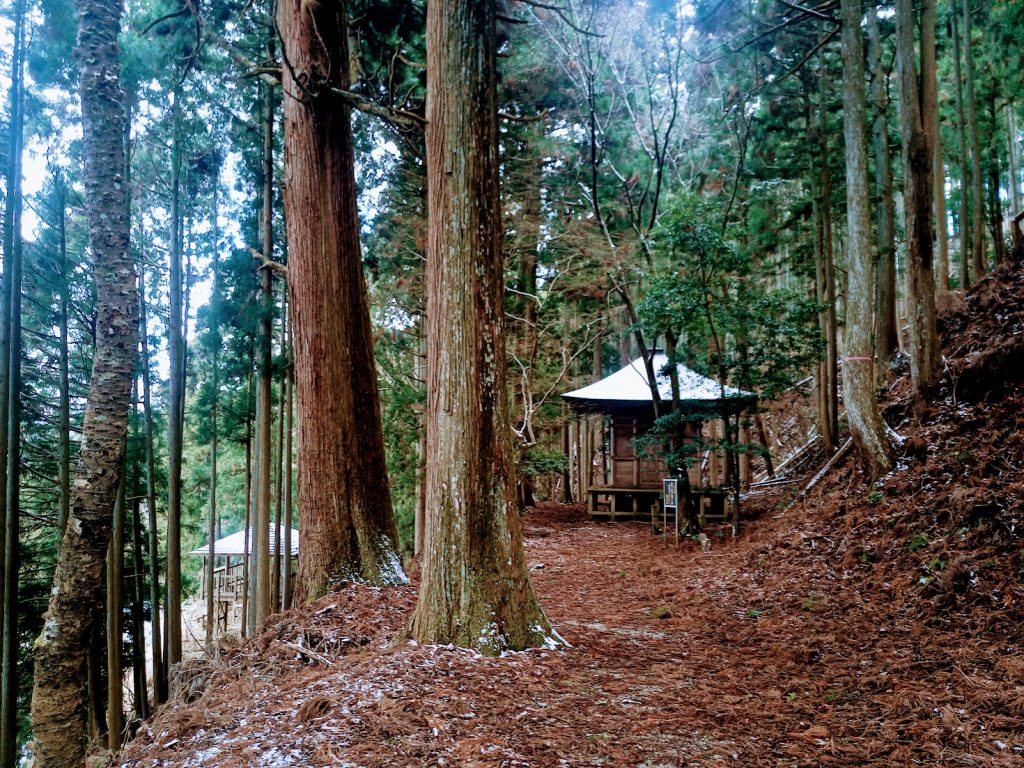
Yoshitsune’s Kakure-to (right side).

The local deity of Yoshinoyama is worshiped here at the Kinpu Shrine. The path to the left leads to Yoshitsune’s Kakure-to.
Yoshitsune no Kakure-to
The Yoshitsune “Kakure-to,” meaning “hidden tower,” is where Yoshitsune is believed to have stayed for awhile in hiding, deep in the backcountry of Yoshino. In good accordance with its description, it is in fact a bit hard to find, located in the highest and most wild area of Yoshinoyama, just below and to the northeast of the secluded Kinpu Shrine. Though the modern building is just a re-creation of the original, it is still used for ritual purposes by local yamabushi monks.
—
The Katte Shrine
Though the shrine grounds remain preserved, Yoshinoyama’s Katte Shrine was ufortunately lost to a fire in the not-so-distant past. It seems to be a place oddly associated with tragic events — it was here that Yoshitsune’s consort, Lady Shizuka, was ordered to dance for Yoritomo after capture due to not being allowed to follow Yoshitsune into the mountains where women were forbidden to tread. Despite her unfriendly audience, it is said she performed a dance in dedication to the lost lover who she sadly would never see again. Lady Shizuka’s fate is a point of contention in history, but it was likely that she was ordered executed by Yoritomo at a later date. As sad as her story was, Lady Shizuka, like Yoshitsune, would go on to become a well-known figure in the popular culture of Japan and remains so to this day.
Interested to learn more and see these places first-hand? Please contact us directly about private tours of the Yoshinoyama area!
All of the locations discussed above are located in and around the Yoshinoyama are of Yoshino Town, Nara Prefecture. Yoshinoyama can be accessed by train from Kintetsu Yoshino Station.

01
FIND YOUR FAVORITE
TRIP ON OUR WEBSITE.
SEND US AN INQUIRY.

02
PERSONALIZE THE TRIP
TO YOUR INTERESTS
WITH OUR CONSULTANT.

03
20% DEPOSIT TO CONFIRM.
BALANCE PRIOR TO ARRIVAL.
PAYMENT BY CC OR TT.

04
WE WILL
MEET YOU
AT THE AIRPORT.

05
DISCOVER THE
TREASURES!